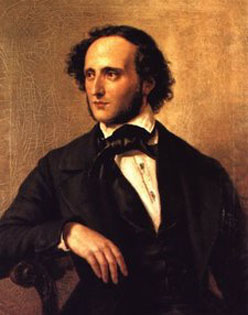Felix Mendelssohn-Bartholdy (1809-1847)
Born February 3, 1809 in Hamburg.
Died November 4, 1847 in Leipzig.
Calm Sea and Prosperous Voyage Overture, Op. 27
Composed: 1828. Revised in 1834.
First Performance: December 1, 1832 at the Sing-Akademie zu Berlin with the composer conducting.
Instrumentation: piccolo, 2 flutes, 2 oboes, 2 clarinets, 2 bassoons, contra bassoon, serpent, 2 horns, 3 trumpets, timpani and strings.
Duration: ~12 minutes.
Meeresstille und glückliche Fahrt is Mendelssohn’s fourth overture. It is based on the great German poet Johann Wolfgang von Goethe’s (1749-1832) pairing of two short poems Meeresstille and Glückliche Fahrt. In 1821 the young Mendelssohn met Goethe in Weimar. Beethoven wrote a cantata based on the same poems in 1815. As a tribute to Beethoven, Mendelssohn set his overture in the same key of D Major.
In the days when ships were wind powered a calm windless sea such as the doldrums was not a good thing. This caused anxiety because there was nothing the sailor could do but wait. You may recall that Agamemnon (who is depicted on the mosaic behind the orchestra) went as far as sacrificing his daughter Iphigenia in order for the wind to stir. The music follows the narrative of the poems. The stillness of the ocean is described by long sustained phrases in the strings in the Adagio opening. Actually the entire overture is generated from a single descending idea that we hear right at the beginning in the basses which is then followed by the clarinets. The “terrible deathly stillness” is interrupted by breezes awakening the sails which is signified by a short flute solo. The prosperous voyage then begins with a molto allegro e vivace passage. After the initial bustle of the sails being unfurled we hear two themes which are both based on the opening idea. The first theme is played by the woodwinds. In an 1828 letter Mendelssohn wrote that “the thick waves will be represented by the contra bassoon.” The second theme is played by the cellos as the ship is making headway. Goethe ends the poems when land is first sighted. Mendelssohn adds a coda in which the ship safely arrives in port. The 3 trumpets, which have been silent until now, play a triumphant fanfare. The piece ends with three sustained chords signifying gratitude of the arriving passengers.
The first private performance was on September 8 1828 at Mendelssohn’s home. The public premiere was at a benefit concert in Berlin on December 1, 1832 in the same venue where he conducted the revival of Bach’s Matthew Passion. After this performance the score was stolen. In 1834 Mendelssohn rewrote it and that is the only version we now have. The revised version received its first performance at Mendelssohn’s own debut at the Gewandhaus in Leipzig on October 4, 1835 .
“Meeresstille” (Calm Sea)
Tiefe Stille herrscht im Wasser,
ohne Regung ruht das Meer,
und bekümmert sieht der Schiffer
glatte Fläche ringsumher.
Keine Luft von keiner Seite!
Todesstille fürchterlich!
In der ungeheuern Weite
reget keine Welle sich.
Deep stillness rules the water,
the sea rests motionless,
and the sailor looks anxiously
at the smooth surface all around him.
No wind from any direction!
A terrible deathly stillness!
In the entire vast expanse
not a single wave rises.
“Glückliche Fahrt” (Prosperous Voyage)
Die Nebel zerreissen,
der Himmel ist helle,
und Aeolus löset
das ängstliche Band.
Es säuseln die Winde,
es rührt sich der Schiffer.
Geschwinde! Geschwinde!
Es teilt sich die Welle,
es naht sich die Ferne.
Schon seh’ ich das Land!
The mist is clearing,
the sky grows bright,
and Aeolus loosens
the constraining bond.
The winds are sighing,
the sailor is roused.
Quickly! Quickly!
The waves divide,
the distance draws near
already I see land!
Resources
[amazon template=iframe image&asin=B00000IX7X][amazon template=iframe image&asin=0486231844]

One Reply to “Mendelssohn : Calm Sea and Prosperous Voyage”